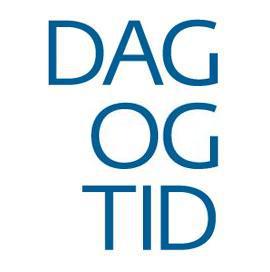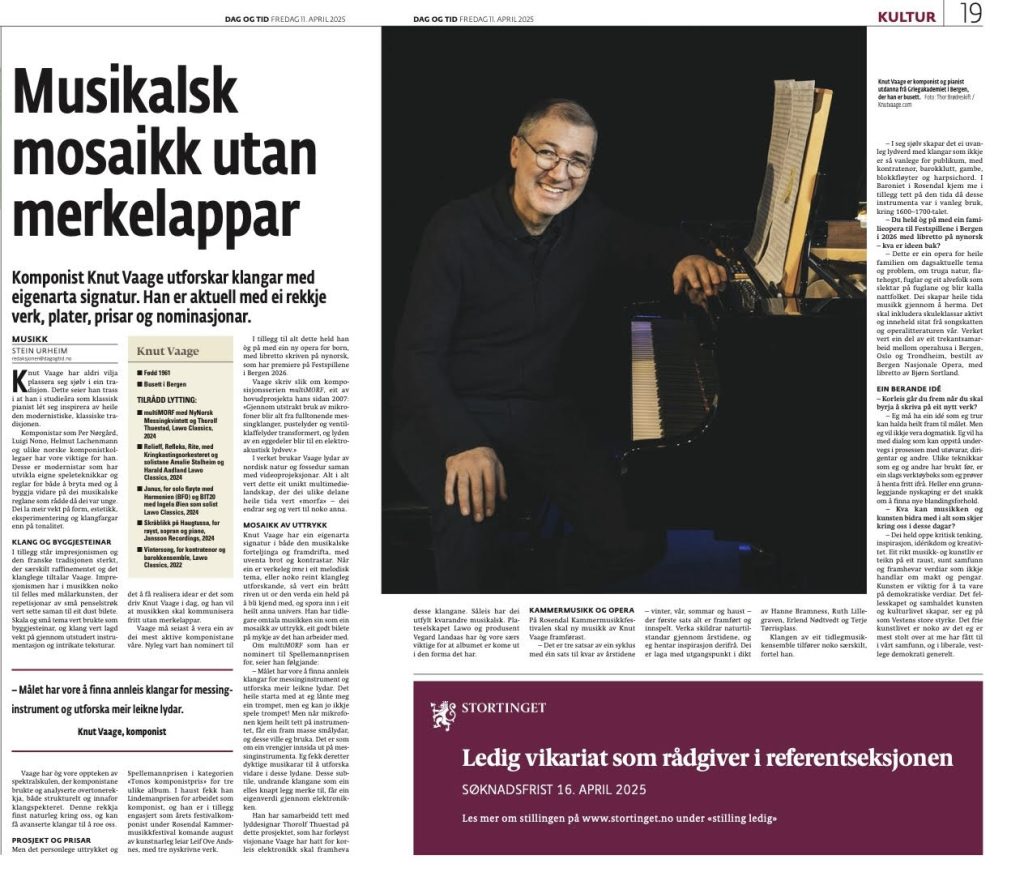
14 Apr Interview in Dag og Tid

Headline: Musical mosaic without labels

Composer Knut Vaage explores sounds with a distinctive signature. He is currently active with a number of works, albums, awards, and nominations.
Text: Stein Urheim
PUBLISHED ON 15.04.2025
Fact box:
Knut Vaage
Born in 1961
Knut Vaage is a composer and pianist educated at the Grieg Academy in Bergen, where he is based.
Recommended listening:
multiMORF with NyNorsk Brass Quintet and Thorolf Thuestad, Lawo Classics, 2024
Relief, Reflection, Rite, with the Norwegian Radio Orchestra and soloists Amalie Stalheim and Harald Aadland, Lawo Classics, 2024
Janus, for solo flute with the Bergen Philharmonic Orchestra (BFO) and BIT20 Ensemble, featuring Ingela Øien as soloist, Lawo Classics, 2024
Skråblikk på Haugtussa, for voice, soprano, and piano, Jansson Recordings, 2024
Vintersong, for countertenor and baroque ensemble, Lawo Classics, 2022
Knut Vaage has never wanted to place himself within a specific tradition. He says this despite being inspired during his student years as a classical pianist by the entire modernist classical tradition.
Composers such as Per Nørgård, Luigi Nono, Helmut Lachenmann, and various Norwegian colleagues have been important influences for him. These are modernists who developed their own playing techniques and sets of rules—both to break with and to build upon the musical conventions that dominated when they were young. They placed greater emphasis on form, aesthetics, experimentation, and tone color than on tonality.
Sound and Building Blocks
In addition, impressionism and the French tradition hold a strong influence, particularly the refinement and sonic qualities that appeal to Vaage. In music, impressionism shares certain traits with painting, where repetitions of small brushstrokes are assembled into a soft, nuanced image. Scales and small motifs are used as building blocks, and sound is emphasized through carefully crafted instrumentation and intricate textures.
Vaage has also been engaged with the spectral school, where composers used and analyzed the overtone series—both structurally and within the sound spectrum. This series exists naturally around us and can make even advanced harmonies feel calming.
Projects and Awards
But it is the personal expression and the realization of ideas that drive Knut Vaage today, and he wants the music to communicate freely—without labels.
Vaage must be considered one of our most active composers. Recently, he was nominated for the Spellemann Award in the category “Tono’s Composer Prize” for three different albums. This autumn, he received the Lindeman Prize for his work as a composer, and he has also been appointed this year’s festival composer at the Rosendal Chamber Music Festival in August by artistic director Leif Ove Andsnes, with three newly commissioned works.
In addition to all this, he is also working on a new opera for children, with a libretto written in Nynorsk, which will premiere at the Bergen International Festival in 2026.
Vaage writes the following about his composition series multiMORF, one of his main projects since 2007:
"Through extensive use of microphones, everything from full-bodied brass sounds, breathing noises, and valve clicks are transformed, and the sound of an egg slicer becomes an electroacoustic soundscape."
In the work, Vaage uses sounds from Nordic nature and the roar of waterfalls combined with video projections. Altogether, this creates a unique multimedia landscape, where the different elements are constantly being "morphed"—changing and transforming into something new.
Mosaic of Expressions
Knut Vaage has a distinctive signature in both musical storytelling and progression, with unexpected breaks and contrasts. Just when one is truly immersed in a melodic theme, or something purely sonically exploratory, one is suddenly torn out of the world one was just beginning to get to know, and led into an entirely different universe. He has previously described his music as a mosaic of expressions — a fitting image for much of what he works with.
About multiMORF, for which he was nominated for the Spellemann Award, he says the following:
- The goal has been to find alternative sounds for brass instruments and to explore more playful tones. It all started when I borrowed a trumpet, even though I can't play the trumpet! But when the microphone is placed very close to the instrument, you can bring out lots of tiny sounds—and those were the ones I wanted to use. It’s as if you turn the brass instruments inside out. I then got skilled musicians to further explore these sounds. These subtle, curious tones that you would hardly notice otherwise gain their own value through the electronics.
He has worked closely with sound designer Thorolf Thuestad on this project, helping to realize Vaage’s visions for how electronics should enhance these sounds. In this way, they have complemented each other musically. The record label Lawo and producer Vegard Landaas have also been crucial in bringing the album to life in its current form.
Chamber Music and Opera
New music by Knut Vaage will be performed at the Rosendal Chamber Music Festival.
There are three movements from a cycle with one movement for each of the seasons—winter, spring, summer, and autumn—where the first movement has already been performed and recorded. The works depict natural states through the seasons, and I draw inspiration from that. They are based on poems by Hanne Bramness, Ruth Lillegraven, Erlend Nødtvedt, and Terje Tørrisplass.
The sound of an early music ensemble adds something special, he says.
- By itself, it creates an unusual soundscape with tones that are not so familiar to the audience, featuring countertenor, baroque lute, viola da gamba, recorders, and harpsichord. At the Barony in Rosendal, we also get close to the era when these instruments were commonly used, around the 1600s–1700s.
You’re also working on a family opera for the Bergen International Festival in 2026 with a libretto in Nynorsk—what’s the idea behind it?
This is an opera for the whole family about current issues and challenges—threatened nature, clear-cutting, birds, and an elf-like people related to the birds, called the Night Folk. They constantly create music by imitating sounds. The work will actively involve school classes and includes quotes from our song heritage and operatic literature. It’s part of a three-way collaboration between the opera houses in Bergen, Oslo, and Trondheim, commissioned by Bergen National Opera, with a libretto by Bjørn Sortland.
A Central Idea
- How do you approach starting a new piece?
- I need to have an idea that I believe can carry all the way to the end. But I don’t want to be dogmatic. I want to include the dialogue that can arise during the process—with performers, conductors, and others. Various techniques that I and others have used before serve as a kind of toolbox that I try to draw from freely. Rather than fundamental innovation, it’s about finding new combinations and balances.
What can music and art contribute in everything happening around us these days?
They uphold critical thinking, inspiration, inventiveness, and creativity. A rich musical and artistic life is a sign of a generous, healthy society and highlights values that are not about power and money. Art is important for safeguarding democratic values. The sense of community and solidarity that art and cultural life create is, in my view, one of the West’s greatest strengths. The free artistic sphere is one of the things I’m most proud that we have achieved in our society—and in liberal Western democracies in general.

Sorry, the comment form is closed at this time.